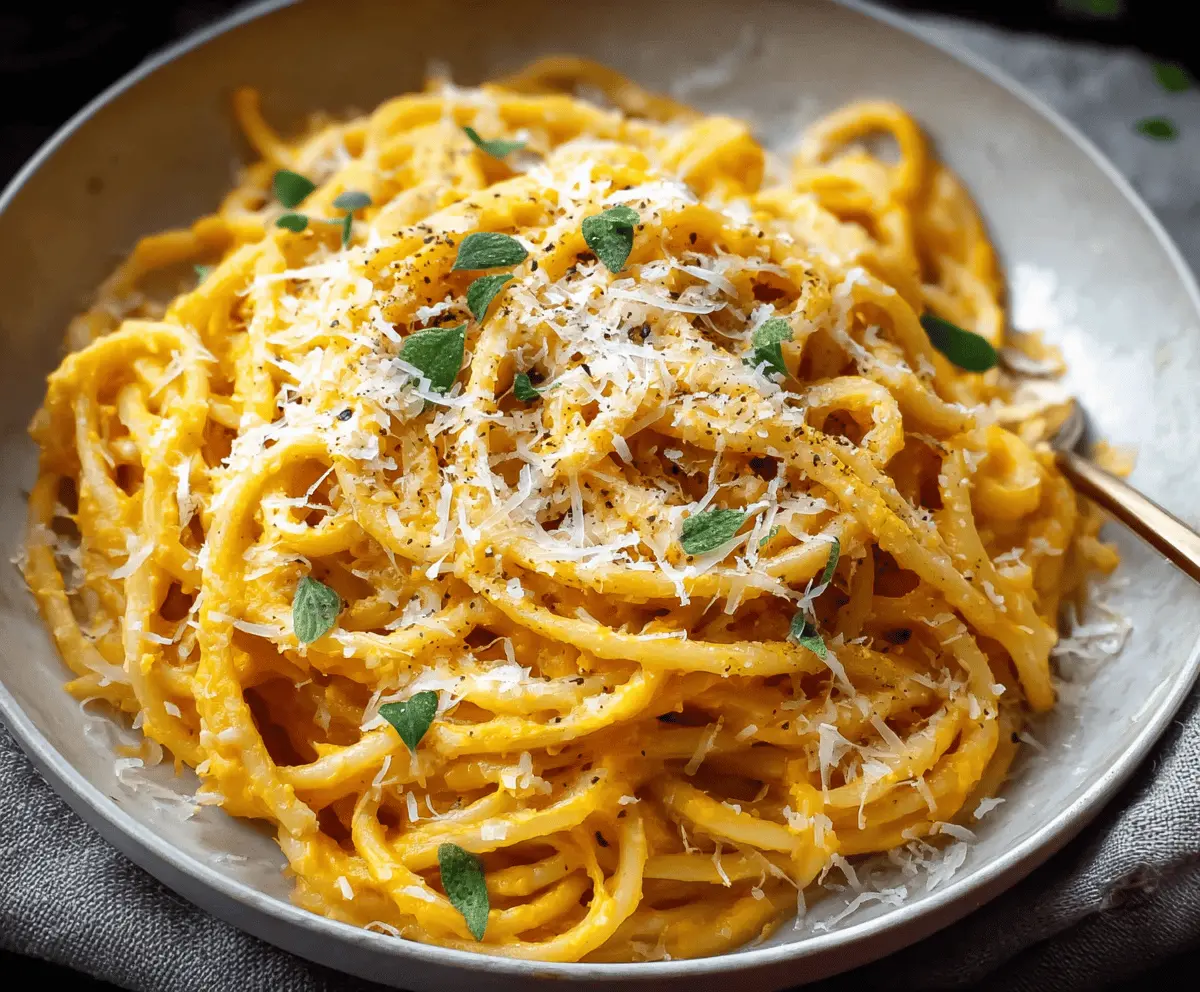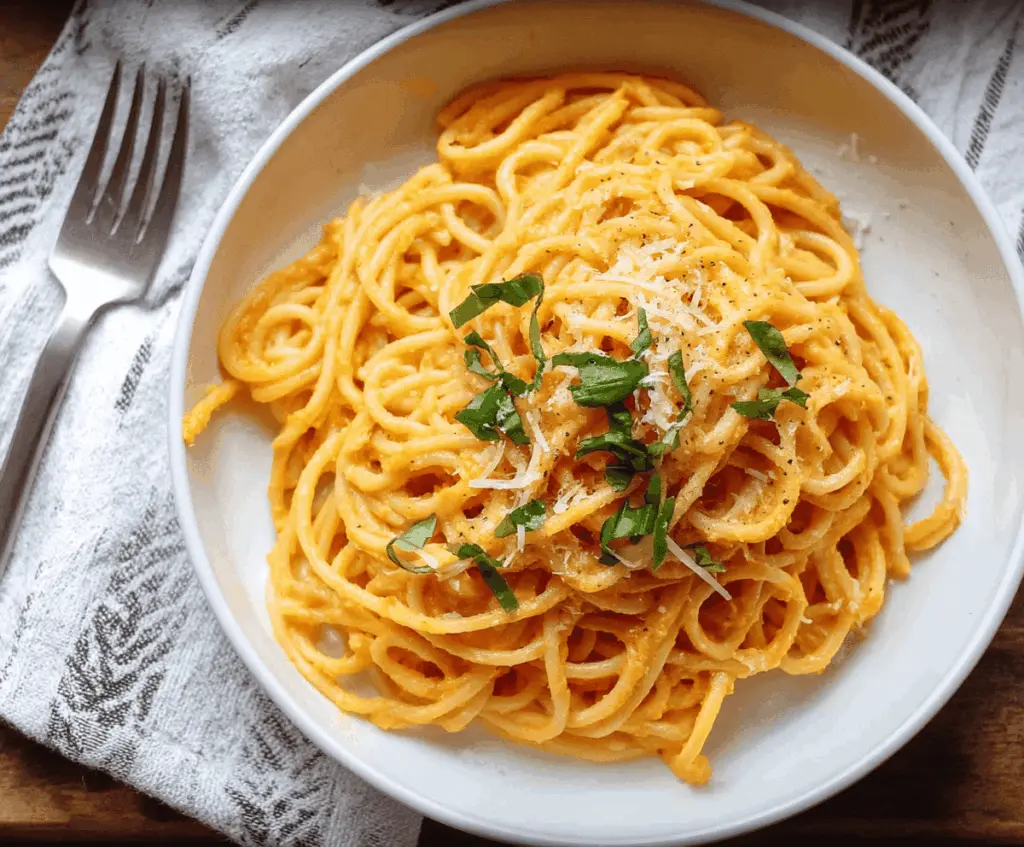Butternut Squash Pasta Sauce is a smooth and creamy delight that brings a sweet, nutty flavor to your favorite pasta. It’s made with roasted butternut squash, blended into a rich sauce that feels comforting but light at the same time. You’ll notice the natural sweetness of the squash coming through, balanced with a bit of garlic and herbs to keep everything tasty and fresh.
I love making this sauce when I want something a little different but still easy to whip up. It’s perfect when you don’t feel like a heavy cream sauce but want something smooth and cozy on your plate. Sometimes I add a sprinkle of parmesan or a pinch of red pepper flakes for a little extra kick, which makes it feel like a fancy dish without any fuss.
For serving, I usually toss it with fettuccine or penne, letting the sauce coat every bite. It’s great topped with fresh parsley or a handful of toasted walnuts for some crunch. This sauce always makes me think of chilly fall evenings, warm kitchens, and simple meals that feel like a big hug.
Key Ingredients & Substitutions
Butternut Squash: This is the star of the sauce, giving it that creamy texture and natural sweetness. If you can’t find butternut squash, try sweet potatoes or pumpkin as a good alternative.
Olive Oil: Used for roasting and sautéing, it adds subtle flavor without overpowering the sauce. You can swap in avocado or sunflower oil if you prefer a lighter taste.
Onion & Garlic: These add depth and a mild savory touch. If you want a milder flavor, use shallots or reduce the garlic amount.
Vegetable Broth: This thins the sauce and adds umami. Water works too but broth makes the sauce tastier. For a dairy-free version, skip the Parmesan and add nutritional yeast instead.
Parmesan Cheese: It adds richness and saltiness. For a vegan or dairy-free option, use nutritional yeast or leave it out entirely.
How Do I Get a Creamy, Smooth Butternut Squash Sauce?
The key to a silky sauce lies in roasting and blending:
- Roast the squash well: This caramelizes the sugars and softens the squash, giving your sauce natural sweetness and smoothness.
- Sauté onions and garlic gently: Softening these brings out their flavor without bitterness.
- Blend thoroughly: Use a high-speed blender or food processor to break down the ingredients until very smooth. If it feels too thick, add broth or pasta water a little at a time to reach a creamy consistency.
- Reheat gently: Warm the sauce slowly to avoid separating or curdling, especially after adding Parmesan.
These steps help your sauce coat pasta beautifully with a rich, velvety finish that feels special but is super simple to make!

Equipment You’ll Need
- Baking sheet – perfect for roasting the butternut squash evenly and getting a nice caramelized flavor.
- Skillet or sauté pan – for softening the onions and garlic without burning them.
- Blender or food processor – to blend the squash and ingredients into a smooth, creamy sauce.
- Large pot – for boiling the pasta until it’s perfectly al dente.
- Wooden spoon or tongs – to toss pasta with sauce without breaking the noodles.
Flavor Variations & Add-Ins
- Add cooked sage or rosemary while sautéing for a warm, herbal twist that pairs well with squash.
- Stir in crumbled cooked sausage or browned ground turkey for a meaty version that adds protein.
- Mix in a handful of spinach or kale at the end for extra greens and a fresh bite.
- Swap Parmesan for goat cheese or cream cheese for a tangier, creamier texture.

Butternut Squash Pasta Sauce
Ingredients You’ll Need:
For The Sauce:
- 1 medium butternut squash (about 2 to 3 pounds), peeled, seeded, and cubed
- 2 tablespoons olive oil
- 1 small onion, chopped
- 2 cloves garlic, minced
- ½ teaspoon salt
- ¼ teaspoon black pepper
- ¼ teaspoon ground nutmeg (optional)
- ½ cup vegetable broth or water (more as needed)
- ¼ cup grated Parmesan cheese (plus extra for serving)
- ¼ cup fresh basil or parsley, chopped, for garnish
For The Pasta:
- 12 oz spaghetti or your favorite pasta
How Much Time Will You Need?
This recipe takes about 40 minutes total. Around 10 minutes for prep, 25-30 minutes for roasting the squash, and a few minutes for cooking pasta and mixing everything together.
Step-by-Step Instructions:
1. Roast the Butternut Squash:
Preheat your oven to 400°F (200°C). Toss the cubed squash with 1 tablespoon olive oil, salt, and pepper. Spread it out on a baking sheet and roast for 25-30 minutes, or until the squash is tender and slightly caramelized.
2. Sauté Onion and Garlic:
While the squash roasts, heat the remaining tablespoon of olive oil in a skillet over medium heat. Add the chopped onion and cook until soft and see-through, about 5 minutes. Then add the garlic and cook for another minute until fragrant.
3. Blend the Sauce:
Put the roasted squash in a blender or food processor along with the sautéed onion and garlic, vegetable broth, and nutmeg if using. Blend until smooth and creamy. If it feels too thick, add a splash more broth or water.
4. Warm and Season the Sauce:
Pour the sauce into a saucepan and warm it gently on low heat. Stir in the grated Parmesan cheese until it melts and blends in. Taste and add more salt or pepper if needed.
5. Cook and Toss the Pasta:
Cook your pasta according to package instructions until al dente. Drain the pasta, saving about half a cup of pasta water. Toss the pasta with the butternut squash sauce, adding a little pasta water if you want it thinner and to help the sauce coat the noodles evenly.
6. Serve:
Dish up your pasta, sprinkle with fresh basil or parsley, extra Parmesan, and freshly ground black pepper. Enjoy your creamy, cozy meal!
Can I Use Frozen Butternut Squash for This Sauce?
Yes! Just make sure to thaw it completely and drain any excess water before roasting to avoid a watery sauce. Roasting frozen squash might take a little longer, so keep an eye on it.
How Can I Make This Recipe Vegan?
Simply omit the Parmesan cheese or replace it with nutritional yeast for a cheesy flavor. Use vegetable broth and olive oil as usual for a delicious vegan-friendly sauce.
Can I Prepare the Sauce Ahead of Time?
Absolutely! You can roast and blend the sauce a day ahead. Keep it refrigerated in an airtight container and gently reheat on the stove, adding a splash of broth or water if it thickens.
What Pasta Types Work Best With This Sauce?
This creamy sauce pairs beautifully with long noodles like spaghetti or fettuccine, but it’s also great on penne or rigatoni. Choose pasta shapes that hold sauce well to get the best flavor in every bite!



